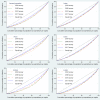Use of oral health care services in Peru: trends of socio-economic inequalities before and after the implementation of Universal Health Assurance
- PMID: 30845948
- PMCID: PMC6407179
- DOI: 10.1186/s12903-019-0731-7
Use of oral health care services in Peru: trends of socio-economic inequalities before and after the implementation of Universal Health Assurance
Abstract
Background: Oral health inequalities are profound worldwide. Despite major improvements in oral health, inequalities exist for many racial and ethnic groups, by socioeconomic status, gender, age, and geographic location. Therefore, the purpose of this study was to investigate trends of socio-economic inequalities in access to oral health services in Peru before and after the implementation of Universal Health Assurance (AUS).
Methods: Analytical cross-sectional study based on the National Household Survey on Living Conditions and Poverty (ENAHO) 2004, 2008, 2010 and 2017. Two periods were defined before and after the AUS Law (2009). Use of oral health services was the dependent variable, for the general population and according to ages, the area of residence, and natural region. Measurements of inequality in the use of health services were made based on the concentration curves (CC), dominance test and concentration index (CI).
Results: We included a number of 85,436 (2004), 88,673 (2008), 87,074 (2010) and 124,142 (2017) participants. The proportion of people who used oral health services was 8.4% (2014), 10.1% (2008), 10.6% (2010) and 10.4% (2017). Use of oral health services showed an increase in different age groups, urban and rural areas, and natural regions of residence during the study period. The CC were distributed below the line of equality, indicating an inequality of use of oral health services, in favor of the richest groups and dominance of the CC in 2017 over the previous years. Changes in the CI were statistically significant for < 5 years and in the rural area, and for the period 2010-2017 they were also significant in the general population, children aged 5-17 years, urban area, and Andean and Jungle regions, which indicates a reduction in the concentration of use of these services in these groups.
Conclusions: The use of oral health services in Peru increased and inequality decreased in the period 2004-2017, coinciding with the implementation of the AUS. However, the use of these services continue having a distribution in favor of the richest populations. It requires the introduction of new strategies and oral health programs in the Peruvian population, with the aim of closing the gap currently mediated by the economic possibilities.
Keywords: Cross-Sectional Studies; Health services misuse; Healthcare disparities; Oral health; Peru (source: MeSH NLM); Surveys and Questionnaires.
Conflict of interest statement
Ethics approval and consent to participate
Not applicable
Consent for publication
Not applicable
Competing interests
The authors declare that they have no competing interests.
Publisher’s Note
Springer Nature remains neutral with regard to jurisdictional claims in published maps and institutional affiliations.
Figures
Similar articles
-
Child health and nutrition in Peru within an antipoverty political agenda: a Countdown to 2015 country case study.Lancet Glob Health. 2016 Jun;4(6):e414-26. doi: 10.1016/S2214-109X(16)00085-1. Lancet Glob Health. 2016. PMID: 27198845
-
Rural and urban disparities in oral hygiene practices among Peruvian children aged less than 12 years: Demographic and Family Health Survey 2018.Rural Remote Health. 2020 Oct;20(4):5933. doi: 10.22605/RRH5933. Epub 2020 Oct 29. Rural Remote Health. 2020. PMID: 33115241
-
Geographic and socioeconomic inequalities in cesarean birth rates in Peru: A comparison between 2009 and 2018.Birth. 2022 Mar;49(1):52-60. doi: 10.1111/birt.12572. Epub 2021 Jul 8. Birth. 2022. PMID: 34240458
-
Inequality in Utilization of Dental Services: A Systematic Review and Meta-analysis.Am J Public Health. 2018 Feb;108(2):e1-e7. doi: 10.2105/AJPH.2017.304180. Epub 2017 Dec 21. Am J Public Health. 2018. PMID: 29267052 Free PMC article.
-
Inequalities and Inequities in Pediatric Respiratory Diseases.Pediatr Clin North Am. 2021 Feb;68(1):293-304. doi: 10.1016/j.pcl.2020.09.017. Pediatr Clin North Am. 2021. PMID: 33228939 Review.
Cited by
-
Oral Health Service Use in Older Peruvians Before and During the COVID-19 Pandemic.Int Dent J. 2024 Jun;74(3):473-481. doi: 10.1016/j.identj.2023.12.003. Epub 2024 Jan 14. Int Dent J. 2024. PMID: 38225185 Free PMC article.
-
Impact of the COVID-19 pandemic on the timing of dental care in elderly peruvians.Acta Odontol Latinoam. 2022 Apr 30;35(1):16-24. doi: 10.54589/aol.35/1/16. Acta Odontol Latinoam. 2022. PMID: 35700537 Free PMC article.
-
Associations between chronic conditions and oral health services utilization in older Peruvian adults: a pooled analysis of the Demographic and Health Survey 2015-2017.Epidemiol Health. 2020;42:e2020023. doi: 10.4178/epih.e2020023. Epub 2020 Apr 9. Epidemiol Health. 2020. PMID: 32272006 Free PMC article.
-
[Impact of dental anxiety on the oral health-related quality of life of older adults in a rural area of Peru].Rev Cient Odontol (Lima). 2025 Mar 3;13(1):e229. doi: 10.21142/2523-2754-1301-2025-229. eCollection 2025 Jan-Mar. Rev Cient Odontol (Lima). 2025. PMID: 40231107 Free PMC article. Spanish.
-
Factors Influencing Adolescents' Knowledge, Practices, and Attitudes Towards Oral Health in the Rupa-Rupa District, Peru.J Int Soc Prev Community Dent. 2024 Dec 27;14(6):469-478. doi: 10.4103/jispcd.jispcd_152_24. eCollection 2024 Nov-Dec. J Int Soc Prev Community Dent. 2024. PMID: 39867628 Free PMC article.
References
-
- WHO. Oral Health. Fact Sheet. https://www.who.int/news-room/fact-sheets/detail/oral-health. Accessed 10 Jan 2019.
-
- Sánchez-Moreno F. El sistema nacional de salud en el Perú. Rev. perú. med. exp. salud publica. 2014;31:747–753. - PubMed
-
- Ortiz-León F. Perfil epidemiológico de salud bucal en niños atendidos en el seguro social del Perú. Odontol Pediatr. 2014;13(2):10.
MeSH terms
LinkOut - more resources
Full Text Sources
Medical
Miscellaneous



